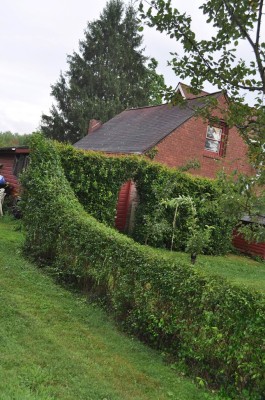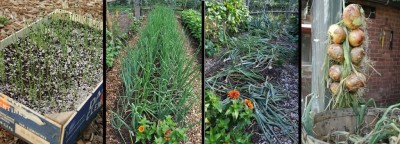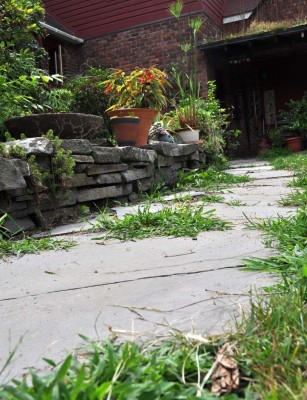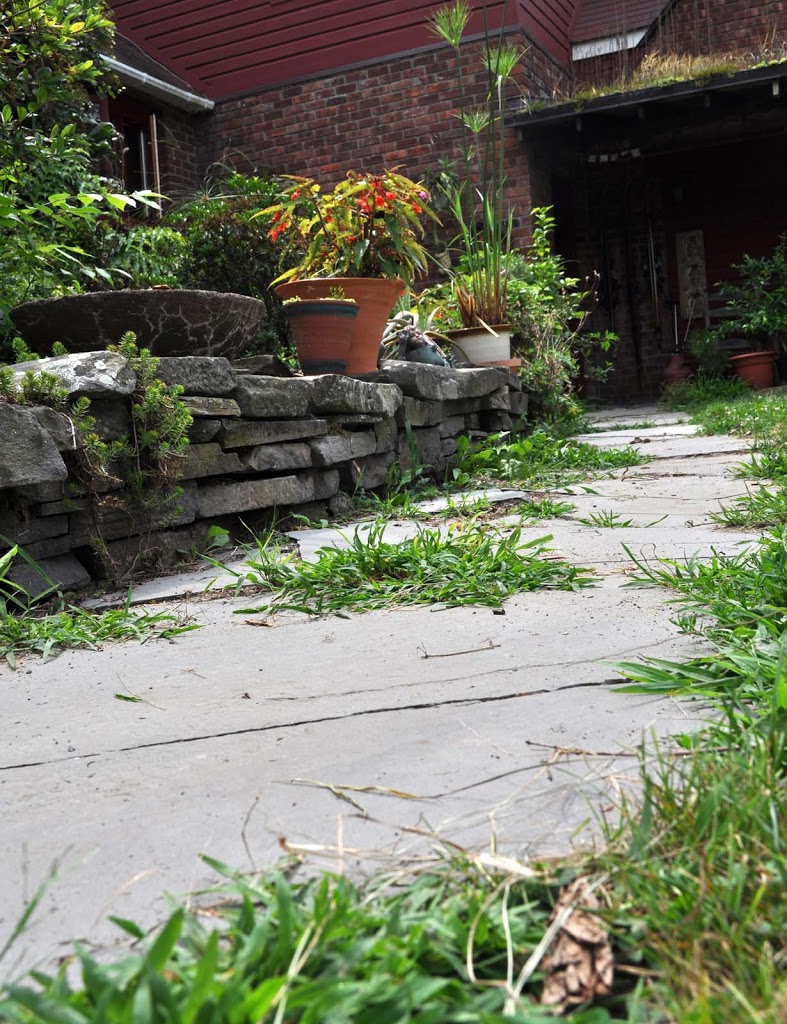[privet, hedge shears, blackberry pruning]
/0 Comments/in Gardening/by Lee A. Reich Privet is a lowly hedge, as far as hedges grow. It’s common, it’s mundane, it’s white flowers give off a sickly aroma in June, its even banned in certain areas because it can be invasive. As implied by the last mentioned feature, it is very easy to grow, and that’s why I planted a 60 foot row of it about 15 years ago.
I planted the privet as a divider between my property and that of my neighbor’s. At only 3 feet high, the hedge is a friendly divider. My neighbor moved and sold the property to me about 8 years ago; the divider stays. Treated with care, privet is a very nice plant.

Neglected, my hedge would grow into a towering behemoth 15 feet high, with a similar spread, a behemoth that would flower profusely to spew its fetid “breath” and spread its seed. At 3 feet high, it never grows big enough to flower.
The coolest thing about privet is its malleability. It also tolerates all manners of pruning, everything from being attired as your standard suburban, clipped hedge to a fanciful topiary in the shape, say, of a dragon (which seemingly lurks within, ready to be unleashed if a privet bush or hedge were to be neglected). I’ve chosen the middle road and shaped my privet conventionally except for its extremities, which swoop up to form arched openings. One end connects with a grove of tall bamboo and the other connects with a row of crabapple trees running perpendicular to the privet along the back edge of my garage.
The sweep of privet has been years in the making. The reason is because dense growth is needed to create a mass of greenery, and dense growth comes from many heading cuts, that is, cuts that shorten, rather than remove stems. The response to heading cuts is increased branching of the remaining portions of stem. Rather than let just a few stems make their way across each arch, I shorten all stems. This slows their progress but makes them denser with branches. For now, the swoop is in place, and the branching stems are still reaching across the arches.
———————————————————–
Good tools or a skilled staff of gardeners are at least part of what help make gardens productive and attractive. I lack the staff but have a few good tools.
Take that privet hedge, for example. I used to maintain it with a set of hand operated hedge shears. They are Sandvik, very high quality and make a satisfying slicing sound as the two sharp blades clipped stems. And that’s all I did with them: For years, the hedge was just a long, rectangular box. Trimming it took too long to bother with anything more fanciful.
From the hand shears, I graduated to electric hedge shears. They made fairly quick work of the hedge but that time was offset by having to unwind a long cord, maneuver it around, and then wind it back up. The cord was always catching on doorways and plants, and I had to be careful not to shear it as I worked. Using the hand shears often provided a simple, quiet respite from the hassle of the electric shears. Short sessions of hand shearing, now and then over the course of a couple days, would get the job done.

A few years ago, I graduated again, this time to Black & Decker cordless electric shears. This is the tool that makes the present privet swoop. I merely walk from one end of the hedge to the other holding the shears against the hedge at the desired level. The cuts are more uniform and now I can focus on the details of the desired shape. Five passes up and down the hedge plus some ladder work on the arch at either end, all taking no more than a half hour a few times each summer, keeps the form alive and growing.
———————————————————
If only the Black & Decker cordless electric shears could be used on more plants, such as my blackberries. This year, they — Doyle Thornless and Chester Thornless — are growing like gangbusters. Both need detailed pruning with fingernails or hand-held pruning shears in summer and again early next spring.

Summer pruning for Chester Thornless entails clipping or pinching off the tips of all new canes when they reach a height of about 4 feet. This pruning (a heading cut, just like with the privet) induces branches on which fruits are borne next summer.
With both varieties, I’ll also cut to the ground all fruiting canes just as soon as they finish fruiting. Each blackberry cane is biennial, fruiting their second year. Once a cane has fruited, it dies so should be pruned away. New canes are always coming up, so the plants fruit every year.
Fortunately, neither variety has yet finished fruiting for the season, and is yielding the best crop ever of sweet, richly flavored blackberries.
[act, onions]
/2 Comments/in Gardening/by Lee A. Reich At last week’s Northeast Permaculture Convergence, I gave a lecture and had the opportunity to attend a lecture, the latter by the diva of dirt, or, at least, of compost tea, specifically aerated compost tea (ACT), Dr. Elaine Ingham. You’ve never heard of ACT!? It’s been the hot, new thing for the past few years, an alleged cure for poor soil and plant diseases. I’ve been skeptical and thought that hearing and speaking to Dr. Ingham in person could entice me into the fold.
Dr. Ingham showed myriad images of fungi, nematodes, and other creatures that you might find in compost piles and teas. We saw many “bad guys” that lurk in poorly aerated composts and teas. The “bad guys” are bad, she asserted, because they release toxins into the soil and puff away as gas valuable nitrogen, sulfur, and phosphorus as, respectively, ammonia (not true, the release would be as nitrogen oxides), hydrogen sulfide, and phosphene (except that most phosphorus from phosphene is re-incorporated into the soil before it even gets away).
Dr. Ingham suggested monitoring our compost pile and tea happenings by purchasing a microscope and, with the help of her workshops, identifying resident microorganisms. Hmmm; interesting, but is it really necessary for a green thumb?
While the panoply of microorganisms discussed was impressive, I contended and contend that even a well-aerated compost pile or tea is bound to have some poorly aerated pockets. It’s not a “bad guys” vs. “good guys” situation, but a question of generally favoring an excess of “good guys.” Also, once compost is spread on the ground, the large surface area presented is going to tip the balance even more in favor of aerobic conditions.
(The photo shows me brewing up some compost tea, which I once tried on a few different plants. Response of plants was nothing, nada, zip, rien.)
More fundamentally, I still question the basic assumptions underlying the use of compost tea. Even if you have beneficial organisms in hand (figuratively) and sprinkle them on the ground, they are bound to expire unless the environment is suitable, in which case they will generally be present anyway. Bulky organic materials, such as compost, manure, leaves, and straw, are what nurture these microorganisms.
Spraying ACT on plant leaves should have little or no effect on plant diseases; again, conditions there are not conducive to their survival. In the evolutionary scheme of things, why would a microorganism that thrives in the dark, moist, nutrient-rich innards of a compost pile survive on the sunny, dry, nutrient-poor surface of a plant leaf, let alone provide any benefits. Independent university studies do not generally support the claims made for compost tea. Good gardening comes form using a pitchfork, not an elixir.
————————————————————–
Onion leaves have yellowed and, on most of the plants, flopped down. That’s a good thing. Onions so elegantly demonstrate their life cycle, waxing and waning in response to the progress of the seasons.
At the base of the leaves, the bulbs have swollen into 4 inch diameter, glossy, white orbs. These orbs trace their beginnings back to early February, when I sowed seeds in flats of potting soil. The three varieties, New York Early, Varsity, and Prince, are so-called “long day” varieties, suitable for northern regions because they start to bulb up in response to our long days of early summer. (In the South, early summer days are not as long as ours, so gardeners down there grow “short day” varieties.)
I sowed seeds back in February in order to give my little seedlings time to make as many green leaves as possible before they shifted gears and started putting their stockpiled energy into bulbs. Each leaf corresponds to a ring in the bulb, and the more and bigger the leaf, the more and thicker the rings. The transplants went into the ground back in early May, four rows of them, with plants 6 inches apart, down one 20-foot-long by 3-foot-wide planting bed. A quick calculation brings that to 160 onions, in theory at least; not every one survived and a few don’t form bulbs worth keeping.

After a few days of curing in the sun to further dry down the leaves, these onions will be ready for storage. Braiding them into string is an attractive and functional way to keep the bulbs in good condition for many months.
—————————————
To really take the onions full cycle, I would save some bulbs until next spring and then plant them out. Leaves would sprout, as they often do during the final weeks of storage, followed by flower-capped seedstalks. Onions are biennials, growing leaves their first season, going dormant, then flowering, setting seed and dying in their second season. Bulbs left in the ground also do this as long as they survive winter outdoors.
In years past, I grew many onions from sets, those dime-sized bulbs available in garden centers in spring. Growing from sets in easy but does restrict you to only the couple of varieties available as sets, and these varieties, while good for storage, yield sharp- rather than sweet-flavored onions.
Sets sometimes send up seedstalks their first season. Gardeners cut down seedstalks to force the plants to make fat bulbs instead. It’s futile; once onions are in that flowering mode, there’s no turning back.
Sets are made by sowing seeds close together in spring. Starved for nutrients and water, the small bulbs that form never grow big enough to sock away enough energy to shift into flowering mode. They go dormant that summer and, if planted out with elbow room the following spring, grow only leaves their second season so that they can continue storing energy for eventual bulbing, just like first year onions from seed.
The problem with onion sets is that if they grow too big their first season, they go to seed their second season. I saw a friend’s onion planting a few weeks ago, a planting grown from sets, and about half the plants were going to seed. Useless, unless you want to collect onions seeds, or want the plants only for their pretty, white starbursts of flowers.
[barnyard grass. purslane, dodder]
/0 Comments/in Gardening/by Lee A. Reich Hot weather and rampant plant growth prompt me to add a word to the traditional English round, “Sumer is icumen in, Lhude sing cuccu!” My new version is “Sumer weeds is icumen in, Lhude sing cuccu!” (“Summer weeds have arrived, Loudly sing, Cuckoo!”)
Almost overnight, big clumps of barnyard grass (Echinochloa crus-galli) have appeared in joints of the flagstone path leading up to my front door. It seems that just a week ago, a combination of hand pulling, weed whacking, and vinegar sprays had those joints free of everything except for a bit of moss. Today I had to cut clumps out with a bread knife that was useless on bread but has proved very useful for in the garden.

Besides being unsightly, those clumps of barnyard grass are unwelcome because they’re spreading. The stems prostrate stems root wherever they touch bare ground. And the emerging seed heads are prolific seed producers – reportedly over 300,000 seeds per square yard.
You might think I should relax because barnyard grass is an annual that flops down dead with the first autumn frost. But all those seeds are going to sit in the soil, some germinating next spring, some the following spring, and on and on. Another of the plant’s common names says it all: panic-grass.
—————————————–
Purslane is another summer weed that’s picked up steam in the past few weeks. The problem with purslane is that you can’t just pull it out and toss it on the ground. The succulent leaves and stems are very resistant to drought, staying plumped up with water even when detached from the roots. Stems and leaves left on the ground take root and become whole, new plants.
A recent meal at a fancy restaurant in New York City solved the purslane problem. I’d always known purslane to be edible but the taste and texture never appealed to me. I thought I’d give purslane another try in the form of the beet, goat cheese, and purslane salad listed on the menu.
The salad was delicious, so for the next dinner at home we weeded and harvested at the same time, on the same plant: purslane. As a matter of fact, the garden seemed to be lacking in sufficient purslane to meet our new found needs. I’m not yet ready to start sowing purslane seed, which you can actually purchase. We’ll just harvest more conservatively.
For all I knew, the purslane in that restaurant salad might have been harvested from cracks in sunny pavement behind the restaurant.
——————————————
For gustatory use, purslane shouldn’t be confused with another, similarly prostrate plant , spotted spurge, about which I wrote a year ago. Stems and leaves of spotted spurge are not succulent. Like other members of the spurge family, spotted spurge exudes a toxic, milky sap when injured.
——————————————-
Yellow threads weaving up, down, and all around clumps of blackberry, dock, and other wild plants along a road recently caught my eye. These threads are the stems of a most interesting summer weed: dodder (Cuscuta spp.)
The reason dodder is yellow and, incidentally, leafless is because it has no chlorophyll. How does it make food, then? It doesn’t! Dodder is a parasitic plant.
Dodder seeds germinate and the plant’s roots enter the soil only long enough to support a few inches of stem growth. Once young dodder grows a few inches tall and comes in contact with a potential plant victim, it inserts a modified root right into the plant. The grounded dodder root dies and the remaining dodder plant spends summer sucking nutrients and carbohydrates from its host plant, offering nothing in return.
Dodder is a very effective weed. It makes many seeds each season, the seeds do not germinate all at once, some waiting years before germinating, and it has a wide range of plant hosts. Like barnyard grass, purslane, and spotted spurge, the first frost of autumn kills the plant. Not the seeds, though.







